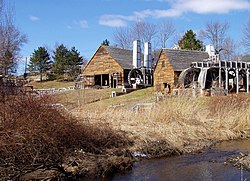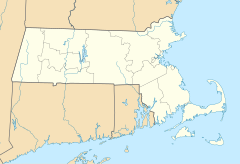Joseph
Jencks I of Saugus Iron Works
First
Patent
Built
First Fire Engine in New World
The
following information is from Wikipedia:
Joseph
Jencks I
(b. England 1602, d. Lynn, MA 1682)
Joseph Jencks settled in Lynn, Massachusetts by 1643, arriving as a widower. On March 6, 1646, he was
awarded the first patent in North America by the General
Court of Massachusetts, for
making scythes. This basic scythe design remained in use for over 300 years. In
1654 he built the first fire engine in North America, commissioned by the city
of Boston. The site of the Jencks forge is at the Saugus Iron Works National Historic Site.
Note if you go to the Iron Works you will not know with out
being told where his forge would have been.
Joseph
Jencks II
(b. England 1632, d. Pawtucket, RI 1717) Arrived in Massachusetts in 1645, having remained in
England until his father was settled. He was the earliest known settler of
Pawtucket, Rhode Island, in 1671. He built and operated the first sawmill in
the area, which was destroyed by fire during King Philip's War. He was a Deputy to the Rhode Island
Assembly for a number of terms in the late 17th century, also Counselor of the
Governor in 1681.
(b. Pawtucket, RI 1656, d. Providence,
RI 1740) From 1691 through 1732, he
continuously held high offices of public trust
in Rhode Island, culminating as Governor from 1727 to 1732
"References
- "Founders of Early American Families", 2nd Revised Edition (2002) by Meredith B. Colket, Jr. and Keith M Sheldon
- "The Jenks Family of America" by W.B. Browne (1952)
- "Genealogical Dictionary of Rhode Island" by John Osborne Austin (Revised 1969 Edition by G. Andrews Moriarty)
- "History of the United States Patent Office" by Kenneth W. Dobyns (1994)"
Marriage for
the Joseph Jenks:
Joseph Jenks
I was married to Sarah Fulwater.
When Joseph
made it to the New World he was a widower.
Their Son
Joseph Jenks II was married to Ester Ballard of Saugus, MA
And their
son Joseph Jenks III was married to Martha Brown.
They had a
daughter Martha Jenkes b.1689 in Pawtucket, RI.
She was my 8th
Great Grandmother.
She married
Pegleg Cook. My question how does a Governors
daughter marry someone named Pegleg Cook???
From Wikipedia:
History of Saugus Iron Works
Saugus Iron Works National Historic Site is a National Historic Site located about 10 miles (16 kilometers) northeast of Downtown Boston in Saugus, Massachusetts. It is the site of the first integrated ironworks in North America, founded by John Winthrop the Younger and in operation between 1646 – 1668. It includes the reconstructed blast furnace, forge, rolling mill, shear, slitter and a quarter-ton drop hammer.
The facility is powered by seven large waterwheels, some of which are rigged to work in tandem with huge wooden gears connecting them. It has a wharf to load the iron onto ocean-going vessels, as well as a large, restored 17th-century house.
Skilled metallurgists John Turner and John Vinton were brought in to manage the fineries. Unskilled laborers cut wood for making charcoal, and quarrying the bog ore and flux.
The site's enclave setting on the Saugus River, featuring an open-air museum with working water wheels, evokes a unique experience for park visitors. These resources demonstrate 17th-century engineering and design methods, iron-making technology and operations, local and overseas trade, and life and work in the Massachusetts Bay Colony.[2]
The original manufacturing site served as a training ground for skilled iron workers for what would become America's iron and steel industry. Iron making provided the infrastructure for the rise of other colonial industries. Called, "the forerunner of America's industrial giants," the site served as a center for technology, innovation and invention. The site interprets early industrial manufacturing, with its enduring social, political and environmental ramifications.[3]
Edit: Current evidence of the "Ironmaster's house" has determined that it was built by a man named Appleton in circa 1681 and that this was long after the iron works had ceased operation. This house, therefore, was not the Iron Master's house as originally portrayed. (Source: National Park Service, Saugus Iron Works"
Between 2005 and 2008 the historic site underwent significant renovations. The 1917 museum building (a chicken coop, turned, blacksmith shop, turned museum) underwent major restoration work and new exhibits were installed during the winter of 2006-2007. Most areas reopened in fall 2007 or spring 2008, however the park is closed seasonally from November to March.
From Wikipedia:
History of Saugus Iron Works
Saugus Iron Works National Historic Site
From Wikipedia, the free encyclopedia
|
Saugus Iron Works National Historic Site
|
|
 |
|
|
Reconstructed Forge and Mill
|
|
|
|
|
| Location: | Off U.S. 1, Saugus, Massachusetts |
|---|---|
| Coordinates: | 42°28′4″N 71°0′32″WCoordinates: 42°28′4″N 71°0′32″W |
| Area: | 9 acres (0.04 km²) |
| Built: | 1648 |
| Visitation: | 11,153 (2006) |
| Governing body: | National Park Service |
| NRHP Reference#: | 66000047[1] |
| Significant dates | |
| Added to NRHP: | October 15, 1966 |
| Designated NHLD: | November 27, 1963 |
| Designated NHS: | April 5, 1968 |
The facility is powered by seven large waterwheels, some of which are rigged to work in tandem with huge wooden gears connecting them. It has a wharf to load the iron onto ocean-going vessels, as well as a large, restored 17th-century house.
Overview
With the archaeological site of the 17th-century iron-making plant, the museum collection, the 17th-century Iron Works House, and the reconstructed iron works complex, Saugus Iron Works National Historic Site illustrates the critical role of iron making to 17th-century settlement and its legacy in shaping the early history of the nation. Sixteen years after the Puritans settled Boston, they built this impressive, large manufacturing complex. At the time there were only a dozen such high-tech plants in all of Europe.Skilled metallurgists John Turner and John Vinton were brought in to manage the fineries. Unskilled laborers cut wood for making charcoal, and quarrying the bog ore and flux.
The site's enclave setting on the Saugus River, featuring an open-air museum with working water wheels, evokes a unique experience for park visitors. These resources demonstrate 17th-century engineering and design methods, iron-making technology and operations, local and overseas trade, and life and work in the Massachusetts Bay Colony.[2]
The original manufacturing site served as a training ground for skilled iron workers for what would become America's iron and steel industry. Iron making provided the infrastructure for the rise of other colonial industries. Called, "the forerunner of America's industrial giants," the site served as a center for technology, innovation and invention. The site interprets early industrial manufacturing, with its enduring social, political and environmental ramifications.[3]
Edit: Current evidence of the "Ironmaster's house" has determined that it was built by a man named Appleton in circa 1681 and that this was long after the iron works had ceased operation. This house, therefore, was not the Iron Master's house as originally portrayed. (Source: National Park Service, Saugus Iron Works"
Site reconstruction and restoration
The blast furnace, forge, rolling and slitting mill, warehouse, and dock area are all reconstructed on original sites and are based upon extensive archaeological excavations done between 1948 and 1953 by Roland W. Robbins. Hundreds of court records, inventories, and accounts of the original iron works were also consulted to produce a full-size (albeit, conjectural) model of the seventeenth century iron works. The "Iron Works House" is a timber framed, 1680s mansion house, still standing on its original location. It was constructed about a decade after the iron works ceased production.[4]Between 2005 and 2008 the historic site underwent significant renovations. The 1917 museum building (a chicken coop, turned, blacksmith shop, turned museum) underwent major restoration work and new exhibits were installed during the winter of 2006-2007. Most areas reopened in fall 2007 or spring 2008, however the park is closed seasonally from November to March.


No comments:
Post a Comment